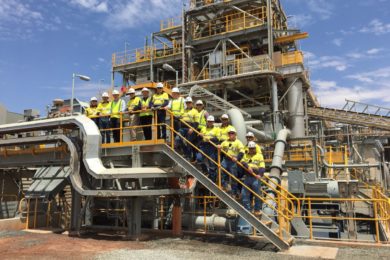The A$65 million Tanami Expansion Project upgraded throughput for the Tanami gold mine, which is owned and operated by Newmont Tanami in the Northern Territory of Australia. The owner’s goal was to increase gold production while improving operational efficiency of the 20-year-old processing plant.
As lead designer, Tetra Tech Proteus (Tetra Tech) designed a safe and efficient installation for additional equipment within the constrained footprint of the existing site. Bentley’s OpenPlant applications provided 3D modeling and isometric generation capabilities that saved the owner about $250,000. The new facilities boosted processing plant productivity from 2.3 to 2.6 Mt/y and provided a safer way to produce backfill material that the site required.
Newmont Tanami took over the Tanami gold mine in 2002 under the aegis of its parent company, Colorado-based global gold producer Newmont Mining Corporation. Located some 540 kilometers northwest of Alice Springs, the fly-in, fly-out operation is in the remote Tanami Desert on Aboriginal freehold land owned by the Warlpiri people. It is an underground mine that produces 459,000 attributable ounces of gold annually. The owner wanted to increase throughput by about 10 percent and gold recovery by about 3%, as part of a plan to extend the life of the mine.
Increasing throughput meant upgrading and expanding equipment situated in tight quarters. Newmont Tanami chose Tetra Tech Proteus, a Tetra Tech subsidiary and leading engineering services provider for the mining sector in Australia, to find a solution that was both space- and cost-efficient. Construction had to be completed with minimal plant downtime and on a tight delivery schedule. The scope of work also included infrastructure improvements such as expanding the accommodations village and improving the communications network.
To retain a modest footprint in the sensitive desert environment, the owner wanted to avoid building the expansion alongside the existing plant. Instead, the company decided to demolish part of the old plant and make room for the new equipment in situ. This included a new ball mill, two gravity concentration circuits, a pre-leach thickener, an electrowinning cell, and a deslime and tailings filtration system. The owner provided 3D models of the existing plant that had been generated from multiple software platforms and were not up to date. The challenge was to convert this legacy information into a detailed plant model that could be modified to design the expansion.
One of the project team’s first tasks was to commission a laser scan of the existing plant. Tetra Tech saved weeks of redrafting time by using Bentley software to convert the outdated plant models and new point-cloud data into a current 3D model. The voluminous survey data provided an unprecedented level of detail. The project team deployed OpenPlant among other Bentley applications to develop comprehensive 3D models, which were used to design all aspects of the expansion and make iterative modifications. Tetra Tech’s value engineering approach focused on identifying every opportunity for savings.
OpenPlant automated multiple tasks, including frequent generation of bulk-count material take-offs (MTOs) for the piping, concrete, and structural steel. MTOs generated from the model added significant value to the project because they were highly accurate, compared to traditional production methods. OpenPlant PID quickly generated the P&IDs required for detailed engineering, while OpenPlant Isometrics Manager generated piping isometric drawings directly from the piping 3D model.
AECOsim Building Designer modelled the structural and concrete components of the plant expansion, and automatically generated annotated plans and elevations for the required deliverables. The project team published i-models directly from AECOsim Building Designer and OpenPlant Modeler, allowing the designers to share models across disciplines. With ProjectWise serving as the connected data environment, multi-discipline models could be compiled as the design evolved. Tetra Tech used Navigator for design reviews, allowing the team to look at potential operational and maintenance issues as well as detect and resolve clashes.
As the design evolved, the project team used OpenPlant PID to batch upload revised data to the P&IDs, then synchronize the drawings with the database. This significantly reduced drafting time, as alterations to the piping components and plant equipment did not require re-tagging. If an overcrowded drawing needed to be split, the associated intelligence accompanied components to the new drawings, saving time that would have been spent redrafting. The project team also reduced labor by using OpenPlant Isometrics’ auto generation capabilities, with its ability to calculate and utilise white space on isometrics.
The interoperability of OpenPlant and AECOsim Building Designer allowed Tetra Tech to automatically label 2D deliverables using the intelligence from the 3D model. Any time a drawing was revised, the data updated automatically, avoiding manual rework. This reduced preparation time required for site plans and elevations by 35 resource hours per drawing, and eliminated rework. Tetra Tech capitalized on this economy by investing the saved hours in the 3D modeling effort. Delivering the 2D drawings and 3D models to shop detailers, off-site fabricators, and on-site contractors provided accurate information as well as the ability to interrogate the models for clarity.
Newmont Tanami ultimately saved $250,000 on project costs thanks to Bentley’s intelligent isometric drawing software, which reduced isometric generation time from three hours to one hour per isometric drawing. Bentley’s interoperable software enabled Tetra Tech to create accurate, intelligent models with the precision required to squeeze the additional equipment into the original plant space. Modeling the exact parameters of the existing area helped the project team reduce the extent and cost of demolition.
Utilising an accurate 3D model of the expanded plant facilities also enhanced project safety components, providing a basis for hazard and operability review, and determining optimal tie-in points. The comprehensive model enabled information mobility among the multi-discipline design team, which in turn led to clearer discussions about methods for egress, maintenance, and crane access and lifting.
The Newmont Tanami expansion effectively revived the dated production facilities and enabled the gold mine to achieve throughput goals within a smaller footprint than would have otherwise been feasible.










